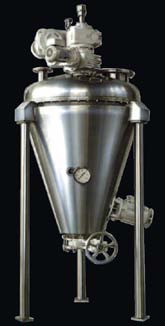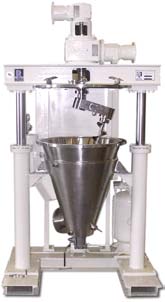Tech Report
Asking the right questions about vertical blenders

Technology Brief
When in the market for a new vertical blender, knowing what questions to ask will help you select the best equipment features that suit your specific application and properly compare offerings from different suppliers.
Vertical blenders: theory of operation
A vertical blender features a slow turning auger screw which orbits a conical vessel wall while it turns and gently lifts material upward. As materials reach the upper most level of the batch, they cascade slowly back down in regions opposite the moving auger screw. This blending mechanism is ideal for products that require low-impact agitation. Vertical blending is also advantageous for heat-sensitive applications and vacuum drying requirements.
In addition to the usual items you generally ask when purchasing equipment (volumetric capacity, material of construction, polish on wetted parts, TEFC or explosion-proof motor and controls, jacketing, vacuum-capability, etc.), below are four questions you need to ask your vertical blender supplier.
Some questions to ask when buying a vertical blender

- Can the blender handle the density of my application? This question is especially important to ask when your product density is around 75 lbs/cu.ft. or higher.
- How will the raw materials be charged into the blender? Depending on the blender size, a dual post air/oil hydraulic lift may be supplied to raise and lower the agitator assembly. This allows raw materials to be charged into the completely open vessel. Another option, more common on large blenders (>10 cu.ft), is to charge ingredients through a port on the vessel cover. The size and location of all sight/charge ports are customizable so be sure to discuss your preferences with your blender supplier.
- Is the auger screw supported from the bottom? An important vertical blender design feature is the absence of a bottom support bearing. A fully top-supported screw auger facilitates complete discharge, simplifies cleaning and reduces contamination risks.
- Do I need a lumpbreaker assembly? The gentle blending action of the screw auger is not suitable for breaking down tough lumps in the batch. For applications that require sufficient shear to reduce the size of lumps, a high speed chopper or lumpbreaker assembly may be installed on the vessel sidewall. Testing is recommended to confirm if a chopper is desirable.
Ross Vertical Blenders




Sample Application: Polymer Powders

A manufacturer of binder resins and specialty additives is using a Ross Vertical Blender for drying polymer powders from 35% to <1% moisture.
The thermoplastic resin was previously being dried in a V-cone tumble blender and transferred to trays for curing in an oven. Afterwards, the powders are milled to disperse agglomerates that have re-formed during curing. This three-step process took 24 hours to complete.
Simulation trials confirmed that the drying and curing steps can be done in a Ross Vertical Blender by following the specified temperature profiles for each stage. The constant agitation of the product prevents agglomerates from forming, therefore eliminating the downstream milling step.
The Ross Vertical Blender chosen for this application is designed for 29"Hg vacuum and temperatures up to 500oF. Heating oil is circulated through the 100-psig stainless steel jacket on the vessel sidewall. A calcium silicate insulation is supplied on the cone and top cover. Fast and 100% complete discharge is achieved by running the fully top-supported auger as the product flows by gravity through the pneumatically-operated knife gate valve. A Type X purge control panel supplied with the blender enables data collection via Ethernet.